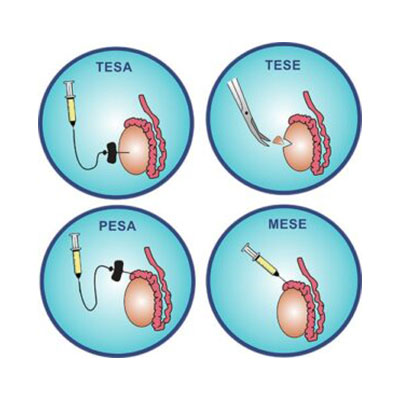Testicular mapping, also known as sperm mapping, is a diagnostic procedure used to locate areas of sperm production within the testes in men with non-obstructive azoospermia (NOA). NOA is a condition where no sperm are found in the ejaculate due to a problem with sperm production. The procedure involves taking multiple small tissue samples from different areas of the testes using a fine needle. These samples are then examined under a microscope to identify the presence of sperm. Testicular mapping helps urologists determine if there are any viable sperm-producing areas that can be targeted for sperm retrieval procedures, such as testicular sperm extraction (TESE), which can then be used for in vitro fertilization (IVF). This targeted approach at Best Infertility Hospital in Karimnagar increases the chances of finding sperm and can avoid unnecessary and potentially damaging surgery on areas of the testes where no sperm are present.
PESA:

PESA stands for Percutaneous Epididymal Sperm Aspiration. It is a minimally invasive procedure for Male Infertility Treatment in Karimnagar used to collect sperm from the epididymis, a coiled tube located at the back of the testicle that stores and carries sperm. PESA is typically recommended for men who have issues with sperm transport, such as blockages in the vas deferens (the tube that carries sperm from the epididymis to the ejaculatory duct) or who have undergone a vasectomy. It is often performed in conjunction with in vitro fertilization (IVF) or intracytoplasmic sperm injection (ICSI), as the retrieved sperm may not be sufficient for natural conception. The procedure involves inserting a fine needle through the skin of the scrotum into the epididymis to aspirate fluid containing sperm. It is usually performed under local anesthesia and has a relatively quick recovery time.
TESA
TESA, or Testicular Sperm Aspiration, is a minor surgical procedure used to retrieve sperm directly from the testes. It involves inserting a fine needle into the testicle and aspirating testicular tissue containing sperm. This technique is recommended for men with azoospermia (absence of sperm in ejaculate) due to blockage or impaired sperm production, men who have undergone vasectomy, or those who cannot produce a sperm sample through ejaculation. TESA is often performed in conjunction with IVF or ICSI to achieve pregnancy.
TESE
TESE, or Testicular Sperm Extraction, is a surgical procedure used to retrieve sperm directly from the testicular tissue. It is typically recommended for men with azoospermia, a condition where no sperm is found in the ejaculate. This can be due to various reasons, including blockages in the reproductive tract, problems with sperm production, or genetic conditions. TESE allows these men to potentially become biological fathers through in vitro fertilization (IVF) or intracytoplasmic sperm injection (ICSI), where the extracted sperm is used to fertilize an egg in the laboratory. It's a vital option for men who would otherwise be unable to conceive as per Male Infertility Doctors in Karimnagar, Dr. Nayani Enjamoori.
Micro TESE
MicroTESE (microscopic testicular sperm extraction) is a surgical procedure used to retrieve sperm directly from the testicles of men with severe male factor infertility, specifically non-obstructive azoospermia (NOA). NOA means there is little to no sperm production in the testicles. The procedure involves a small incision and the use of a microscope to carefully examine testicular tissue and identify areas most likely to contain sperm. It is recommended when conventional methods of sperm retrieval are unsuccessful, or when a man has conditions like Klinefelter syndrome, a history of chemotherapy or radiation, or genetic issues affecting sperm production. MicroTESE offers a higher chance of finding sperm at 9e Fertility compared to random biopsies and minimizes damage to testicular tissue.
